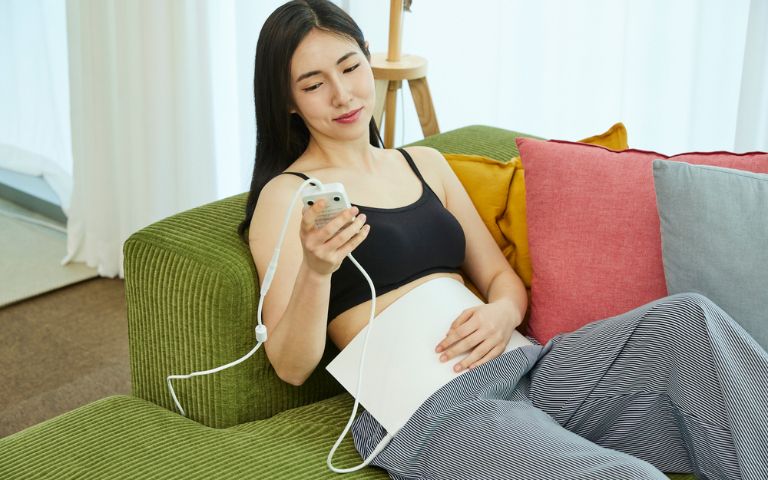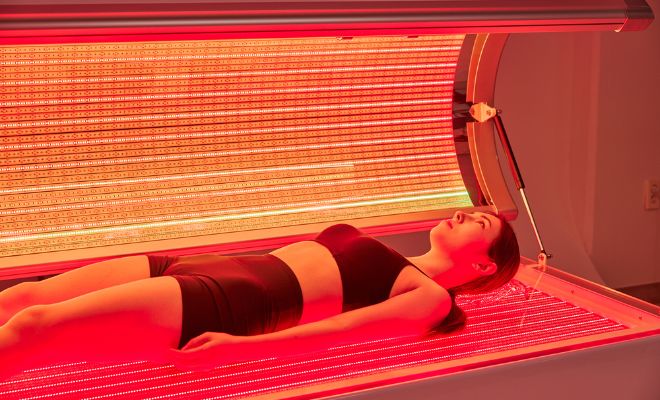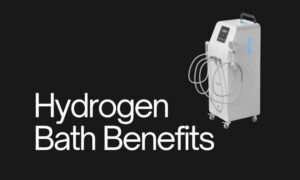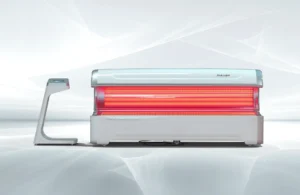Red light therapy (RLT), also known as photobiomodulation (PBM), is gaining attention not only for skin health and muscle recovery but also for its potential to support digestion, reduce inflammation, and enhance metabolic function when applied to the abdominal area.
Emerging research suggests that targeted light wavelengths may help improve gut barrier function, reduce bloating, support fat metabolism, and even ease abdominal discomfort related to the menstrual cycle.
In this article, we explore how red light therapy works on the stomach, the most up-to-date benefits backed by science, practical ways to use it, and essential safety tips before starting.
What is Red Light Therapy?

Red light therapy (RLT) is a non-invasive treatment that uses specific wavelengths of red (typically 620–660 nanometers) and near-infrared light (810–850 nanometers) to trigger beneficial biological effects in the body. These wavelengths are absorbed by your cells, especially the mitochondria, often called the “powerhouses” of cells, where they help produce more energy in the form of ATP (adenosine triphosphate).
How Does Red Light Therapy Work?
When these effects are directed toward the abdominal region, they can help support organ function, reduce inflammation, and promote healing in the digestive tract.
- ATP Production: The light activates an enzyme called cytochrome c oxidase within mitochondria, boosting ATP synthesis. This increase in cellular energy enhances overall cell function and recovery.
- Reduced Oxidative Stress: Red light helps balance harmful free radicals and supports antioxidant activity, lowering inflammation and preventing cellular damage.
- Improved Blood Circulation: It promotes vasodilation and improves microcirculation, ensuring better delivery of oxygen and nutrients to tissues.
Why the Abdomen?
When these effects are targeted toward the abdominal area, they can do more than just energize your cells:
- Support digestive health by promoting cellular repair in the gut lining
- Reduce local inflammation in organs like the intestines and liver
- Enhance nutrient absorption and blood flow to vital abdominal tissues
Benefits of Red Light Therapy on the Stomach Area
1. Supports Gut Lining Repair
One of the most promising benefits of red light therapy (RLT) for digestive health is its ability to heal and strengthen the intestinal lining. This lining is made of epithelial cells that act as a crucial barrier, preventing toxins, pathogens, and undigested food particles from entering the bloodstream.
How Red Light Therapy Helps:
- Stimulates the regeneration of epithelial cells to improve the integrity of the gut barrier.
- Reduces local inflammation, creating an optimal environment for tissue repair.
- Enhances tight junctions, which helps prevent conditions like “leaky gut.”
Real-World Application:
In conditions like gastritis, ulcers, or intestinal inflammation, RLT may support the healing of the mucosal lining. While it shouldn’t replace prescribed medication, it can serve as a complementary therapy to speed up recovery and improve gut resilience.
2. Reduces Inflammation in the GI Tract
Digestive inflammation is more common than you think, and it’s often behind chronic bloating, abdominal discomfort, and even more serious issues like Inflammatory Bowel Disease (IBD).
Mechanism of action:
Red light therapy works by calming the body’s inflammatory response. It does this by:
- Lowering pro-inflammatory cytokines like TNF-α and IL-6
- Stimulating anti-inflammatory signals, which help rebalance immune activity in the gut
What the science says:
Animal studies have shown noticeable reductions in colonic inflammation after red or near-infrared (NIR) light exposure. Early human trials also suggest that red light therapy may help ease bloating and abdominal pain in people with functional GI disorders.
3. Improves Blood Flow and Oxygen Delivery
Poor circulation is often an overlooked contributor to gastrointestinal issues. Inadequate blood flow means less oxygen and nutrients reaching your digestive organs, which can lead to slower healing and impaired digestion.
Red light therapy enhances vascular function in several ways:.
- Promotes vasodilation: It helps widen blood vessels, improving circulation in the abdominal region.
- Stimulates nitric oxide release: This natural molecule boosts blood flow and oxygen transport.
- Encourages capillary formation: New micro-vessels support better tissue repair and nutrient exchange.
By improving blood flow, RLT supports faster healing, reduces inflammation, and optimizes the function of key organs like the intestines, liver, and stomach. The result? Enhanced digestion, better nutrient absorption, and less strain on your gut.
4. Stimulates the Enteric Nervous System (Gut-Brain Axis)
Your gut and brain are in constant communication, thanks to the vagus nerve and the enteric nervous system, a complex web of neurons embedded in the gut wall. This connection, often referred to as the gut-brain axis, plays a crucial role in digestion, mood, and overall health.
How Red Light Therapy (RLT) May Help:
- Enhances vagal tone, which regulates digestion, inflammation, and the body’s stress response.
- Normalizes gut motility, potentially reducing symptoms like constipation or diarrhea.
- Improves stress resilience, helping to ease gut issues triggered by anxiety or chronic stress.
- Emerging studies suggest that applying red light to the abdomen or neck can stimulate vagal activity, leading to better digestion, improved sleep, and a more balanced mood.
Emerging research: Light applied to the abdomen or neck area may positively affect vagal activity, improving not just digestion but mood and sleep as well.
Who Might Benefit: People with Irritable Bowel Syndrome (IBS), especially those whose symptoms are linked to stress or anxiety, may find relief through regular red light therapy targeting the stomach or vagus nerve region.
5. Supports Fat Loss in the Abdominal Area
Red light therapy isn’t a quick fix for weight loss, but studies show it may support fat reduction, particularly around the stomach. It works by enhancing your body’s natural fat metabolism processes, making it a valuable tool when combined with proper diet and exercise.
How it works:
- Stimulates mitochondria: Red and near-infrared (NIR) light boosts cellular energy production (ATP), increasing your body’s metabolic rate.
- Promotes lipolysis: The therapy encourages the breakdown of stored fat cells, particularly in targeted areas like the abdomen.
- Improves insulin sensitivity: Better insulin response reduces fat accumulation and supports balanced blood sugar levels.
What the research says:
Clinical studies have reported measurable reductions in abdominal fat following consistent red light therapy sessions, especially when paired with exercise and healthy eating habits. The therapy appears to be most effective for visceral fat, which is closely linked to chronic diseases such as diabetes and cardiovascular conditions.
6. Reduces Cramping and Menstrual Discomfort (for Women)
For women, red light therapy offers a drug-free way to manage menstrual cramps and related discomfort in the stomach area.
How RLT helps:
- Relaxes the smooth muscle tissue in the uterus and lower abdomen, reducing spasms.
- Improves circulation, which helps relieve cramping and reduce blood stagnation.
- Lowers inflammation by reducing inflammatory mediators that spike during menstruation.
- Soothes digestive issues like bloating and constipation, which often accompany periods.
Use tip: Apply a red light therapy belt or panel to your lower abdomen for 15–20 minutes during menstruation. Many women report significant relief without needing over-the-counter pain meds.
How to Apply Red Light Therapy to the Stomach
1. Choose the Right Device and Wavelength
Not all red light therapy devices are created equal, especially when you’re targeting the abdominal area. For the best results, look for:
- Device Type: Use a high-quality LED panel or a wraparound belt that offers strong and even light output.
- Wavelength Range:
- 630–660 nm: Ideal for surface-level skin concerns like inflammation or stretch marks.
- 810–850 nm (Near-Infrared): Crucial if you’re aiming to reach deeper layers, such as digestive organs or stubborn visceral fat.
Pro Tip: Near-infrared light is non-visible to the naked eye but penetrates deeper tissues, making it essential for internal health goals.
2. Duration and Frequency
To get the best results, start with sessions lasting 10 to 20 minutes, three to five times per week. If you want to accelerate improvements, you can gradually increase the frequency. Just make sure to follow your device’s guidelines and listen to your body’s signals.
Most users begin to notice benefits like reduced bloating or improved digestion after 2 to 4 weeks of consistent use. For those dealing with chronic conditions, a longer trial period of 8 to 12 weeks may be needed to see significant results.
3. Placement
For the best results, place the device directly over the area you want to target, either the upper or lower abdomen, depending on whether you’re focusing on the stomach lining or the colon. Make sure the device has direct contact with your skin or that any clothing is minimal to avoid blocking the light. It’s helpful to relax in a seated or lying down position so the light can evenly cover the area.
Bonus Tip: Try combining red light therapy with deep breathing or relaxation techniques to boost vagal nerve stimulation and promote digestive calm.
Scientific Evidence and Ongoing Research
Red light therapy (RLT) has well-established benefits for skin health and pain relief. However, its potential impact on gut and metabolic health is an exciting area that’s still being explored.
What we know so far:
- Animal studies suggest that photobiomodulation (PBM) can reduce gut inflammation, promote a healthier microbiome, and speed healing of ulcers and damaged mucosa.
- Early human studies indicate improvements in gut motility, relief from IBS symptoms, and reductions in visceral fat.
What researchers are currently investigating:
- How PBM modulates the gut microbiota
- The effects of abdominal red light therapy on insulin resistance
- Its influence on vagal tone and the gut-brain axis
As more clinical trials are completed, we anticipate a clearer understanding of how to best use RLT to support digestive and metabolic health.
Safety Considerations
Red light therapy is generally non-invasive, painless, and safe for home use when used properly. However, it’s important to follow some precautions:
Avoid using red light therapy over:
- Active tumors (unless under medical supervision)
- Pregnant abdomen (always consult your physician first)
- Open wounds or active infections
General guidelines to keep in mind:
- Don’t exceed the recommended session lengths.
- Avoid looking directly into the light source.
- Stop using it immediately if you notice skin irritation or any unusual symptoms.
Ready to Experience the Benefits? Start with Huelight’s PBM Abdomen Irradiator

If you’re looking to harness the powerful benefits of red light therapy for your stomach and digestive health, it’s important to choose a device designed specifically for those needs—one that won’t leave your progress to chance.
That’s where Huelight’s Abdominal PBM Irradiator comes in. This medical-grade, FDA-cleared device is engineered specifically for abdominal and gut-related care. Unlike generic red light panels, it features 544 high-quality LEDs that deliver optimized wavelengths (810–940nm). These wavelengths penetrate deeply into abdominal tissues to target inflammation, improve circulation, and support cellular repair exactly where your body needs it most.
What makes this device stand out?
- Clinically validated technology using Dr. Nogier’s 8-step frequency modes, providing personalized gut and metabolic therapy
- Ergonomic, lightweight design that wraps comfortably around your abdomen, waist, or pelvis
- Proven safety certifications (FDA, CE, GMP) trusted by wellness clinics and healthcare professionals worldwide
- Multi-zone treatment coverage—ideal for those experiencing bloating, IBS, menstrual cramps, or abdominal fat accumulation
If you’re serious about improving digestion, calming inflammation, and boosting metabolism from the inside out, this device could be the missing piece in your wellness routine.
Take control of your gut health today with Huelight’s Abdominal PBM Irradiator.













